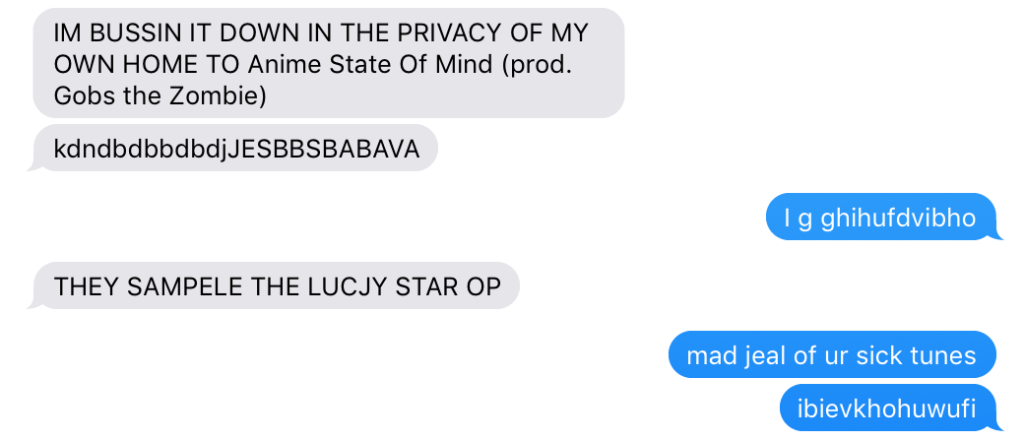bururber [14:04]: at my old job we hired this dude who was utterly incompetent and literally said “for sure”
bururber [14:04]: seventeen times in one hour
edible incredible [14:05]: FLHXKXK RTIBKB
edible incredible [14:05]: Fer sherrrrr
Conversation between two online friends from a private Discord Server, reproduced with permission.
I’d have to go back a few years in my internet time machine to first remember when I keysmashed. While this is theoretically possible, the idea of looking through five plus years of online communication is incredibly exhausting to even consider, so I decided to give “keysmash” a google instead. Results ranged from articles by people who clearly don’t know what they’re on about to a weirdly accurate UrbanDictionary definition by user ‘ur the best, ur amazing, hbd.’:
A key smash is exactly that, a random smashing of the keyboard that conveys intense or overwhelming emotion that cannot be expressed through words. However, there is an art to this trade. For the perfect key smash, use the “Home Keys” on your keyboard; this includes the letters a,s,d,f,j,k,l,; as well as g and h. The typical start letters are “a” and “j” but any of the Home Keys can be used. Once you have perfected your key smash, you can begin throwing in letters from the other rows for a personal touch. It is a staple of the LGBT community and a versatile conversational tool.
UrbanDictionary, “Key smash”
This is, along with its included examples (which I will discuss further below), a much more satisfactory explanation than I found in an article on CounterPunch:
On May 30th, dictionary.com’s word of the day was keysmash, defined as “a random string of letters and symbols typed out on a keyboard or touchscreen, used to signal intense emotion in written communication.”
^%G&%@#D#^=FU*(&^*#@*
This entire piece could be nothing but keysmashes.
Missie Comley Beattie, “Keysmash”
I don’t know how old Beattie is, or how much time she spends on the internet, but I can venture a guess: she was not 13-20 during the 2010s, and she did not have a blog on tumblr.com. As someone who falls into these demographic groups and adopted “keysmashing” as a part of my online communication sometime in the last decade, I can definitely point out some issues with her impersonation of this paralinguistic feature.
First: there are way too many symbols, and not enough letters. In examples from my conversations online over the past few weeks, there are a handful of variations. Looking at the screencap below, you can see that my hands (in blue) favour the centre section of the keyboard when I’m expressing this extreme emotion, with features characters like “g,” “h,” “k,” and “f,” but I’ll occasionally stray up from the Home Row for flourishes (we see “u,” “o,” “w,” and “i” a lot). My friend, however, who is using a SmartPhone rather than the laptop that I was using to type, favours “k,” “n,” “d,” “b,” “a,” “v,” which includes more characters from the lower half of the keyboard (which would make sense, given how one holds their phone when texting). In fact, sociolinguist Gretch McCulloch is quoted as saying that there are patterns of keysmashes based on whether somebody is a touch-typer (uses the Home Row of keys to type without looking at the keyboard), is on their mobile phone, or uses an unconventional keyboard layout, like Dvorak.¹
Despite these differences in our input and personal flair, you don’t see gratuitous use of symbols or anything that one would need to hold down the shift key to achieve. To me, the keysmash from Beattie’s article is written by someone who is blending or confusing their idea of the keysmash with the jumble of special characters often used to substitute profanity in mass media (like “F$&*,” “S*!%,” “C@*!,” for “fuck,” “shit,” “cunt”). While special characters don’t necessarily fit into natural keysmashes, I would argue that “;” and “‘” have their places in them since they are either on the Home Row of keys or are on the periphery and do not require any extra articulatory effort (holding the shift key) to produce.

Another (albeit smaller) issue with Beattie’s impersonation of keysmashing is that the only alphabetic characters in her keysmash are capitalized. While keysmashes of the most peripheral extremes can be exclusively in caps (as it is in the example at the beginning of this blog post) or, as seen above, shift from all lowercase to all caps, the prototypical keysmash is in all lower case, as is seen in the examples given on UrbanDictionary:
The key smash can be used in virtually any scenario to display urgency or intensity of one’s emotions or situation.
Humor: “ajkshwdkljxg lmaooooo”
UrbanDictionary, “Key smash”
Tragedy: oh my goodnessalsdgkwnlzkgjkssd idek what to say that’s terrible!
Anger: WHAT?! AKXZNVJLKKSALDFKALD;GH I CANT BELIEVE YOU DID THAT!
Distrust: Yeah, as if ifasazksfdfs if if if if I’m gonna let you use my tractor.
Suprise/Denial: AKXFDJSKAHFKLDHAZSJAGQKJDHFJKS NO WAY!!!
Happiness: OMG YESSSHFDHQJKLDSHGJXSFG
Anxiety: nononononono afjdkahdjhgakkjl no way I can’ttttfjadkhk
We also see in the examples above that keysmashes can be suffixed onto the last words in an “utterance”² or phrase. While they can definitely occur by themselves, given context, they add different emotions to different situations. McCulloch further proves that these keysmashes are meaningful, intelligible utterances to those who use them when she says that “the majority of people will delete and remash if they don’t like what it looks like.”³ This isn’t something you’d do with something that was intentionally nonsensical–the practice of deleting and starting anew as used by speakers of Internet English who use keysmashing to express themselves in itself proves that there’s something going on there that bears semantic weight. Thinking on that, it would be an interesting study to see which keysmashes were perceived as more or less authentic and/or situation appropriate based on their properties (I would imagine that one could look at the letters used and their location on the keyboard, frequency of the letters used, capitalization, length of the keysmash, and/or any use of special characters like in Beattie’s construction).
For my last point, though, let us return, to the body of the definition given by UrbanDictionary, where the author of the dictionary entry refers to the keysmash as a “staple of the LGBT community.” As I mentioned earlier, I personally associate the advent of keysmashing with the online culture prevalent on the social media website Tumblr, which, at its peak and still to this day, was well-known for its large and oftentimes eccentric LGBTQ+ community. As we entered the 2010s, it became more common practice to list your pronouns in your bio; we talked more about the issues of representation, queer baiting and “bury your gays” as they related to pop culture; and I personally watched “gay” as a descriptor morph from something that upset me as a queer person, because I was tired of my teenage peers using it to demean everything they didn’t like, to a word I use regularly in both an ironic and literal sense sense (during a long-term relationship, I referred to my partner as “gay” both jokingly when she was being an idiot or sincerely, when she was being incredibly sweet). I don’t know how to put it better than to say that, for all its ridiculousness, Tumblr did make for a very positive place on the internet for queer kids to retreat to.
It’s interesting, this clearly-observed relationship between Tumblr culture and keysmashing. If the people of UrbanDictionary voted the above as their top definition, its assertion that keysmashing is a staple of LGBT culture must hold some weight to a large online community (and an online community that can come up with a better definition than our CounterPunch writer could). Whether or not it is the objective truth, subjective value holds a lot of weight in linguistics or in any social science because it informs critical viewers of the expectations of the mainstream. Again, this cultural attitude ties to my earlier curiosity: what would the results be of a scientific study of the reception of keysmashing? While I’m sure that all of the weird and negative associations that Tumblr now has are still indexed to some by keysmashing, it has moved relatively seamlessly into the mainstream and can be seen on other social media sites like Twitter and Instagram, implying to me that keysmashing is liable to be a lasting trend for users of Internet English.
Endnotes:
¹Perlman, “How ‘Keysmash’ became the way internet users expressed their emotions.”
²I will consider many of these spontaneous bursts of online communication, like instant messages, to be utterances, since they mirror spoken English in their spontaneity and casual nature, and often do not form “complete sentences.”
³Perlman, “‘Keysmash’.”
Works Cited:
‘ur the best, ur amazing, hbd.’ “Key smash.” (24 Aug., 2018) UrbanDictionary. Link.
Beattie, Missy C. “Keysmash.” (2 Jun. 2017). Counterpunch, Petrolia: CA. Accessed 29 Oct., 2019. Link.
Perlman, Merrill. “How ‘Keysmash’ became the way internet users expressed their emotions.” (16 Sept. 2019). Columbia Journalism Review, New York: NY. Accessed 29 Oct., 2019. Link.
